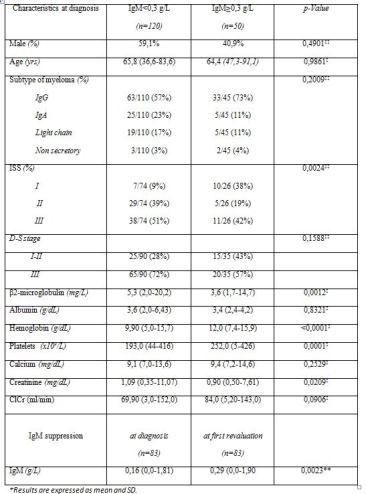POLYCLONAL SERUM IGM AS A PROGNOSTIC MARKER IN NEWLY DIAGNOSED MULTIPLE MYELOMA
(Abstract release date: 05/19/16)
EHA Library. Napolitano M. 06/09/16; 132869; E1320
Disclosure(s): Nothing to disclose

Dr. Mariasanta Napolitano
Contributions
Contributions
Abstract
Abstract: E1320
Type: Eposter Presentation
Background
Normal serum IgM plasma levels have been reported as an independent marker of good prognosis in patients with multiple myeloma (MM) but their role has been poorly investigated
Aims
We aimed to evaluate the role of polyclonal serum IgM levels as a surrogate marker of normal residual bone marrow function in newly diagnosed patients with multiple myeloma (NDMM).
Methods
Data were collected from the enrolling Hematology Centers. Patients with NDMM were evaluated for polyclonal IgM levels and their correlation with clinical and laboratory parameters of MM, at diagnosis and up to one year after standard treatment. Baseline data were retrospectively analyzed between January 2012 and June 2015; analyzed parameters were taken at the following time-points: diagnosis, after standard treatment and 1 year after diagnosis. The one-year evaluation was performed at least 3 months after the last autologous stem cell transplant (ASCT) and at least 2 months after the end of a first-line treatment in patients not eligible for ASCT. A dedicated database was created. Statistical analysis was performed with Medcalc 12.5.00. Wilcoxon test for paired samples was applied when indicated Patients were divided into two groups based on the serum IgM levels at diagnosis (IgM<0.3 g/L and IgM > 0.3 g/L,respectively).
Results
At diagnosis, we evaluated 170 NDMM (not IgM myeloma) patients and divided them into two groups based on polyclonal serum IgM levels (Table). M protein type frequency was similar between both groups. We found that patients with polyclonal serum IgM level higher than 0,3 g/L had higher hemoglobin levels (median 12,0 vs. 9,90 g/dL; p<0,0001) and platelet count (252 x 109L-1 vs. 193 x 109L-1; p=0,0001), lower β2-microglobulin (3,6 vs. 5,3 mg/L; p=0,0012), lower creatinine levels (0,90 mg/dl vs. 1,09 mg/dl; p=0,0209), higher creatinine clearance (ClCr, 84 mL/min vs. 69,90 ml/min; p=0,0906), lower frequency of ISS stage III (42% vs. 51%; p=0,0024). No significant statistical correlation was found between IgM plasma levels and LDH, serum calcium and albumin. At regression analysis, a strong correlation between polyclonal serum IgM level and serum beta-2 microglobulin (negative; p=0,034) and hemoglobin (positive; p<0,001) was observed.At the first revaluation, data on 98 patients were available. When comparing serum IgM polyclonal levels between diagnosis and first re-evaluation, IgM at diagnosis resulted lower (0, 16 g/L vs. 0, 29 g/L; p=0, 0023).Overall survival was similar between both groups (82, 8 vs. 82 months; p=0, 9118) and it was unrelated to the type of treatment administered.
Conclusion
In newly diagnosed MM, normal IgM levels can be evaluated as a surrogate marker of good bone marrow residual function in NDMM. After treatment, IgM do not statistically correlate with any of the clinical and laboratory prognostic markers examined.

Session topic: E-poster
Keyword(s): Diagnosis, Prognostic factor
Type: Eposter Presentation
Background
Normal serum IgM plasma levels have been reported as an independent marker of good prognosis in patients with multiple myeloma (MM) but their role has been poorly investigated
Aims
We aimed to evaluate the role of polyclonal serum IgM levels as a surrogate marker of normal residual bone marrow function in newly diagnosed patients with multiple myeloma (NDMM).
Methods
Data were collected from the enrolling Hematology Centers. Patients with NDMM were evaluated for polyclonal IgM levels and their correlation with clinical and laboratory parameters of MM, at diagnosis and up to one year after standard treatment. Baseline data were retrospectively analyzed between January 2012 and June 2015; analyzed parameters were taken at the following time-points: diagnosis, after standard treatment and 1 year after diagnosis. The one-year evaluation was performed at least 3 months after the last autologous stem cell transplant (ASCT) and at least 2 months after the end of a first-line treatment in patients not eligible for ASCT. A dedicated database was created. Statistical analysis was performed with Medcalc 12.5.00. Wilcoxon test for paired samples was applied when indicated Patients were divided into two groups based on the serum IgM levels at diagnosis (IgM<0.3 g/L and IgM > 0.3 g/L,respectively).
Results
At diagnosis, we evaluated 170 NDMM (not IgM myeloma) patients and divided them into two groups based on polyclonal serum IgM levels (Table). M protein type frequency was similar between both groups. We found that patients with polyclonal serum IgM level higher than 0,3 g/L had higher hemoglobin levels (median 12,0 vs. 9,90 g/dL; p<0,0001) and platelet count (252 x 109L-1 vs. 193 x 109L-1; p=0,0001), lower β2-microglobulin (3,6 vs. 5,3 mg/L; p=0,0012), lower creatinine levels (0,90 mg/dl vs. 1,09 mg/dl; p=0,0209), higher creatinine clearance (ClCr, 84 mL/min vs. 69,90 ml/min; p=0,0906), lower frequency of ISS stage III (42% vs. 51%; p=0,0024). No significant statistical correlation was found between IgM plasma levels and LDH, serum calcium and albumin. At regression analysis, a strong correlation between polyclonal serum IgM level and serum beta-2 microglobulin (negative; p=0,034) and hemoglobin (positive; p<0,001) was observed.At the first revaluation, data on 98 patients were available. When comparing serum IgM polyclonal levels between diagnosis and first re-evaluation, IgM at diagnosis resulted lower (0, 16 g/L vs. 0, 29 g/L; p=0, 0023).Overall survival was similar between both groups (82, 8 vs. 82 months; p=0, 9118) and it was unrelated to the type of treatment administered.
Conclusion
In newly diagnosed MM, normal IgM levels can be evaluated as a surrogate marker of good bone marrow residual function in NDMM. After treatment, IgM do not statistically correlate with any of the clinical and laboratory prognostic markers examined.

Session topic: E-poster
Keyword(s): Diagnosis, Prognostic factor
Abstract: E1320
Type: Eposter Presentation
Background
Normal serum IgM plasma levels have been reported as an independent marker of good prognosis in patients with multiple myeloma (MM) but their role has been poorly investigated
Aims
We aimed to evaluate the role of polyclonal serum IgM levels as a surrogate marker of normal residual bone marrow function in newly diagnosed patients with multiple myeloma (NDMM).
Methods
Data were collected from the enrolling Hematology Centers. Patients with NDMM were evaluated for polyclonal IgM levels and their correlation with clinical and laboratory parameters of MM, at diagnosis and up to one year after standard treatment. Baseline data were retrospectively analyzed between January 2012 and June 2015; analyzed parameters were taken at the following time-points: diagnosis, after standard treatment and 1 year after diagnosis. The one-year evaluation was performed at least 3 months after the last autologous stem cell transplant (ASCT) and at least 2 months after the end of a first-line treatment in patients not eligible for ASCT. A dedicated database was created. Statistical analysis was performed with Medcalc 12.5.00. Wilcoxon test for paired samples was applied when indicated Patients were divided into two groups based on the serum IgM levels at diagnosis (IgM<0.3 g/L and IgM > 0.3 g/L,respectively).
Results
At diagnosis, we evaluated 170 NDMM (not IgM myeloma) patients and divided them into two groups based on polyclonal serum IgM levels (Table). M protein type frequency was similar between both groups. We found that patients with polyclonal serum IgM level higher than 0,3 g/L had higher hemoglobin levels (median 12,0 vs. 9,90 g/dL; p<0,0001) and platelet count (252 x 109L-1 vs. 193 x 109L-1; p=0,0001), lower β2-microglobulin (3,6 vs. 5,3 mg/L; p=0,0012), lower creatinine levels (0,90 mg/dl vs. 1,09 mg/dl; p=0,0209), higher creatinine clearance (ClCr, 84 mL/min vs. 69,90 ml/min; p=0,0906), lower frequency of ISS stage III (42% vs. 51%; p=0,0024). No significant statistical correlation was found between IgM plasma levels and LDH, serum calcium and albumin. At regression analysis, a strong correlation between polyclonal serum IgM level and serum beta-2 microglobulin (negative; p=0,034) and hemoglobin (positive; p<0,001) was observed.At the first revaluation, data on 98 patients were available. When comparing serum IgM polyclonal levels between diagnosis and first re-evaluation, IgM at diagnosis resulted lower (0, 16 g/L vs. 0, 29 g/L; p=0, 0023).Overall survival was similar between both groups (82, 8 vs. 82 months; p=0, 9118) and it was unrelated to the type of treatment administered.
Conclusion
In newly diagnosed MM, normal IgM levels can be evaluated as a surrogate marker of good bone marrow residual function in NDMM. After treatment, IgM do not statistically correlate with any of the clinical and laboratory prognostic markers examined.

Session topic: E-poster
Keyword(s): Diagnosis, Prognostic factor
Type: Eposter Presentation
Background
Normal serum IgM plasma levels have been reported as an independent marker of good prognosis in patients with multiple myeloma (MM) but their role has been poorly investigated
Aims
We aimed to evaluate the role of polyclonal serum IgM levels as a surrogate marker of normal residual bone marrow function in newly diagnosed patients with multiple myeloma (NDMM).
Methods
Data were collected from the enrolling Hematology Centers. Patients with NDMM were evaluated for polyclonal IgM levels and their correlation with clinical and laboratory parameters of MM, at diagnosis and up to one year after standard treatment. Baseline data were retrospectively analyzed between January 2012 and June 2015; analyzed parameters were taken at the following time-points: diagnosis, after standard treatment and 1 year after diagnosis. The one-year evaluation was performed at least 3 months after the last autologous stem cell transplant (ASCT) and at least 2 months after the end of a first-line treatment in patients not eligible for ASCT. A dedicated database was created. Statistical analysis was performed with Medcalc 12.5.00. Wilcoxon test for paired samples was applied when indicated Patients were divided into two groups based on the serum IgM levels at diagnosis (IgM<0.3 g/L and IgM > 0.3 g/L,respectively).
Results
At diagnosis, we evaluated 170 NDMM (not IgM myeloma) patients and divided them into two groups based on polyclonal serum IgM levels (Table). M protein type frequency was similar between both groups. We found that patients with polyclonal serum IgM level higher than 0,3 g/L had higher hemoglobin levels (median 12,0 vs. 9,90 g/dL; p<0,0001) and platelet count (252 x 109L-1 vs. 193 x 109L-1; p=0,0001), lower β2-microglobulin (3,6 vs. 5,3 mg/L; p=0,0012), lower creatinine levels (0,90 mg/dl vs. 1,09 mg/dl; p=0,0209), higher creatinine clearance (ClCr, 84 mL/min vs. 69,90 ml/min; p=0,0906), lower frequency of ISS stage III (42% vs. 51%; p=0,0024). No significant statistical correlation was found between IgM plasma levels and LDH, serum calcium and albumin. At regression analysis, a strong correlation between polyclonal serum IgM level and serum beta-2 microglobulin (negative; p=0,034) and hemoglobin (positive; p<0,001) was observed.At the first revaluation, data on 98 patients were available. When comparing serum IgM polyclonal levels between diagnosis and first re-evaluation, IgM at diagnosis resulted lower (0, 16 g/L vs. 0, 29 g/L; p=0, 0023).Overall survival was similar between both groups (82, 8 vs. 82 months; p=0, 9118) and it was unrelated to the type of treatment administered.
Conclusion
In newly diagnosed MM, normal IgM levels can be evaluated as a surrogate marker of good bone marrow residual function in NDMM. After treatment, IgM do not statistically correlate with any of the clinical and laboratory prognostic markers examined.

Session topic: E-poster
Keyword(s): Diagnosis, Prognostic factor
{{ help_message }}
{{filter}}


